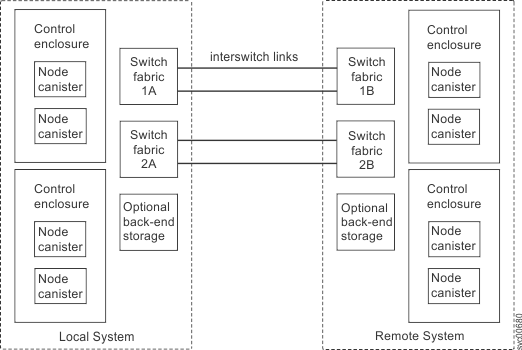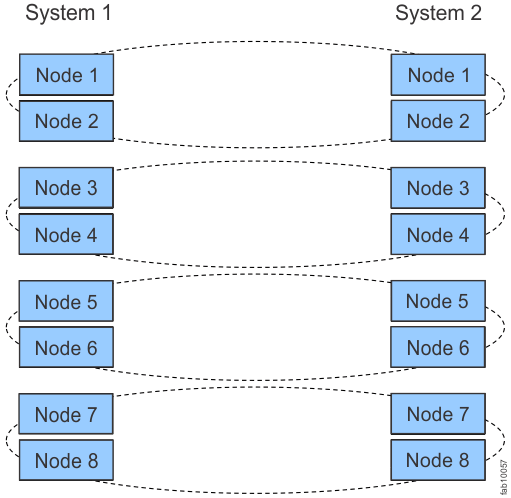The
links between clustered system pairs that perform remote mirroring must meet specific
configuration, latency, and distance requirements.
Figure 1 shows an example of a configuration
that uses dual redundant fabrics that can be configured for Fibre
Channel connections. Part of each fabric is located at the local system
and the remote system. There is no direct connection between the two
fabrics.
Figure 1. Redundant fabrics

You can use Fibre Channel extenders
or SAN routers to increase the distance between two systems. Fibre Channel extenders transmit Fibre Channel packets across long links without changing the contents of the packets.
SAN routers provide virtual N_ports on two or more SANs to extend
the scope of the SAN. The SAN router distributes the traffic from
one virtual N_port to the other virtual N_port. The two Fibre
Channel fabrics are independent of each other. Therefore,
N_ports on each of the fabrics cannot directly log in to each other.
See the following website for specific firmware levels and the latest
supported hardware:https://datacentersupport.lenovo.com/us/en/products/storage/lenovo-storage/v3700v2/6535
If you use Fibre Channel extenders or SAN routers, you must meet the
following requirements:
- The maximum supported round-trip latency between
sites depends on the type of partnership between systems, the version
of software, and the system hardware that is used. Table 1 lists the maximum round-trip latency. This restriction applies to
all variant of remote mirroring. More configuration requirements and
guidelines apply to systems that perform remote mirroring over extended
distances, where the round-trip time is greater than 80 ms.
Table 1. Maximum supported round-trip latency between sites
| Software version |
System node hardware |
Partnership |
| FC |
1 Gbps IP |
10 Gbps IP |
| 7.3.0 and earlier |
All |
80 ms |
80 ms |
10 ms |
| 7.4.0 and later |
|
250 ms |
| All other models |
80 ms |
- The round-trip latency between sites cannot
exceed 80 ms for either Fibre Channel extenders
or SAN routers. This maximum round-trip latency applies to all variants
of remote mirroring, including Global Mirror with change volumes and
IP partnership.
- Metro Mirror and Global Mirror require 2.6 Mbps of bandwidth for intersystem heartbeat traffic.
- If the link between two sites is configured with redundancy so
that it can tolerate single failures, the link must be sized so that
the bandwidth and latency statements are correct during single failure
conditions.
- The configuration is tested to confirm that any failover mechanisms
in the intrasystem links interoperate satisfactorily with Lenovo Storage V series systems.
- All other configuration requirements are met.
Configuration requirements for systems
that perform remote mirroring over extended distances (greater than
80 ms round-trip latency between sites)
If you use remote
mirroring between systems with 80 - 250 ms round-trip latency, you
must meet the following additional requirements:
In addition to the preceding list of requirements, the following
guidelines are provided for optimizing performance for remote mirroring
by using Global Mirror:
- Partnered systems should use the same number of nodes in each
system for replication.
- For maximum throughput, all nodes in each system should be used
for replication, both in terms of balancing the preferred node assignment
for volumes and for providing intersystem Fibre Channel connectivity.
- On Lenovo Storage V series systems, provisioning dedicated node ports for
local node-to-node traffic (by using port masking) isolates Global
Mirror node-to-node traffic between the local nodes from other local
SAN traffic. As a result, optimal response times can be achieved.
This configuration of local node port masking is less of a requirement
on Storwize family systems, where traffic between node canisters in
an I/O group is serviced by the dedicated inter-canister link in the
enclosure.
- Where possible, use the minimum number of partnerships between
systems. For example, assume site A contains systems A1 and A2, and
site B contains systems B1 and B2. In this scenario, creating separate
partnerships between pairs of systems (such as A1-B1 and A2-B2) offers
greater performance for Global Mirror replication between sites than
a configuration with partnerships that are defined between all four
systems.
Limitations on host-to-system distances
There is no limit on the Fibre Channel optical
distance between Lenovo Storage V series nodes and host servers. You can attach a server
to an edge switch in a core-edge configuration with the Lenovo Storage V series system at the core. Lenovo Storage V series systems support up to three ISL hops in the fabric.
Therefore, the host server and the Lenovo Storage V series system can be separated by up to five Fibre Channel links. If you
use longwave small form-factor pluggable (SFP) transceivers, four of the Fibre Channel links can be
up to 10 km long.

